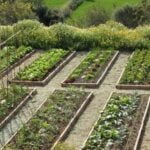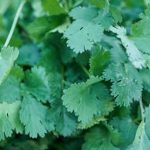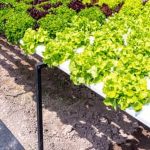Are treated pine sleepers safe for vegetable gardens? This question has sparked a lot of debate among gardeners and homeowners.
Treated pine sleepers are a popular choice for building raised beds in vegetable gardens, but concerns about the safety of the chemicals used in the treatment process have raised some red flags. In this article, we will explore the benefits and potential risks of using treated pine sleepers in vegetable gardens, as well as alternative options and tips for making an informed decision.
Treated pine sleepers are commonly used in landscaping and gardening due to their durability and resistance to decay. They are often treated with chemicals to protect them from insect damage and fungal decay, which can extend their lifespan significantly. However, the types of chemicals used in this treatment process have raised concerns about their safety when used in close proximity to edible plants.
Understanding the treatment process for pine sleepers is essential in determining their safety for vegetable gardens. It’s important to know what chemicals are used, how they are applied, and whether they can potentially leach into the soil and affect plant growth. In this article, we will delve into the specifics of the treatment process and its potential implications for vegetable gardens.
Understanding the Treatment Process for Pine Sleepers
Treated pine sleepers are a popular choice for landscaping and gardening projects, including vegetable gardens. Understanding the treatment process for pine sleepers is essential in determining their safety for use in vegetable gardens. The treatment process involves impregnating the wood with preservatives to protect it against decay, insects, and other environmental factors that could cause it to deteriorate over time.
The treatment process for pine sleepers typically involves the use of chemicals such as copper azole or alkaline copper quaternary (ACQ). These chemicals help to increase the durability and lifespan of the wood, making it suitable for outdoor use. However, there have been concerns about the potential risks of using treated pine sleepers in vegetable gardens, particularly with regards to the leaching of chemicals into the soil and potential harm to plant roots.
To ensure the safety of treated pine sleepers in vegetable gardens, it is important to consider the following factors:
- Choose properly treated pine sleepers: When purchasing treated pine sleepers for your vegetable garden, look for products that have been certified as safe for use in contact with soil, such as those that meet relevant industry standards.
- Use a barrier: To minimize the risk of chemical leaching into the soil, consider using a barrier such as heavy-duty plastic sheeting between the treated pine sleepers and the soil in your vegetable garden.
- Consider alternatives: If you have concerns about using treated pine sleepers in your vegetable garden, there are alternative materials that you can consider, such as untreated hardwood sleepers or composite materials.
By understanding the treatment process for pine sleepers and taking appropriate precautions, you can minimize any potential risks associated with their use in your vegetable garden.
Potential Risks of Treated Pine Sleepers in Vegetable Gardens
When it comes to using treated pine sleepers in vegetable gardens, there are some potential risks that gardeners should be aware of. The treatment process for pine sleepers involves the use of chemicals that could potentially leach into the soil, and eventually into the plants themselves. Here are some of the potential risks to consider:
- Chemical Leaching: One of the main concerns with using treated pine sleepers in vegetable gardens is the risk of chemical leaching. The chemicals used to treat the wood can potentially leach into the soil over time, and may be absorbed by the plants.
- Potential Health Risks: If these chemicals are absorbed by the plants, there is a potential health risk for those consuming vegetables grown in treated pine sleeper beds. Certain chemicals used in treating pine sleepers have been associated with health issues when ingested.
- Environmental Impact: In addition to potential health risks, there is also an environmental impact to consider. Chemicals leaching from treated pine sleeper beds can have a negative impact on the surrounding environment, including water sources and nearby plant life.
To minimize these risks, there are several precautions that gardeners can take when using treated pine sleepers in their vegetable gardens:
- Use a liner: One option to help prevent chemical leaching is to use a plastic or landscaping fabric liner inside the sleeper beds, creating a barrier between the treated wood and the soil.
- Choose alternative treatments: Look for alternatives such as ACQ (Alkaline Copper Quaternary) or copper azole treatments that are considered safer for use in vegetable gardens.
- Opt for raised beds: Instead of using treated timber directly in contact with soil, opt for raised garden beds with a safe liner material such as HDPE plastic or recycled plastic lumber.
By taking these precautions, gardeners can help minimize any potential risks associated with using treated pine sleepers while still enjoying their benefits as a versatile and durable material for building raised beds.
How to Minimize Risks in Using Treated Pine Sleepers
The use of treated pine sleepers in vegetable gardens can raise concerns about the potential risks that the treatment chemicals may pose to plants, soil, and even human health. However, there are ways to minimize these risks and safely use treated pine sleepers in your garden.
One way to minimize the risks associated with treated pine sleepers is to ensure that they have been properly treated. Look for products that have been treated using a high-pressure treatment process, which forces preservatives deep into the wood where they are less likely to leach out. Avoid products that have only been dip-treated or spray-treated, as these methods may not provide adequate protection against decay and insect damage.
Another way to reduce the risks of using treated pine sleepers in vegetable gardens is to line them with plastic sheeting before filling them with soil. This will create a barrier between the wood and the soil, reducing the chances of any treatment chemicals leaching into the growing medium. Additionally, using a geotextile fabric between the sleeper and plastic lining can help prevent punctures and tears on the plastic from sharp corners.
It is also important to regularly monitor your vegetable garden for any signs of deterioration or chemical leaching from the treated pine sleepers. Keep an eye out for any changes in plant growth or health, as well as any unusual odors or discoloration of the soil. By staying vigilant and taking proactive measures, you can significantly minimize the potential risks associated with using treated pine sleepers in your vegetable garden.
| Ways to Minimize Risks | Description |
|---|---|
| Proper Treatment Process | Look for high-pressure treated products |
| Use Plastic Sheeting | Line sleepers with plastic to create a barrier between wood and soil |
| Regular Monitoring | Keep an eye on plant growth, soil color, and odors for signs of issues |
Alternatives to Treated Pine Sleepers for Vegetable Gardens
When considering the use of treated pine sleepers in vegetable gardens, it’s important to be aware of the potential risks involved in using this material. While treated pine sleepers can be a convenient and affordable option for constructing garden beds, there are alternatives that may be better suited for a vegetable garden environment.
Untreated Hardwood Sleepers
One alternative to treated pine sleepers is using untreated hardwood sleepers. Hardwood sleepers are naturally resistant to decay and have a longer lifespan compared to pine, making them a durable choice for vegetable garden beds. Additionally, untreated hardwood sleepers do not pose the same risks of leaching chemicals into the soil as treated pine sleepers.
Composite Sleepers
Another alternative to consider is using composite sleepers, which are made from a combination of recycled wood and plastic. Composite sleepers offer the look of real wood with the added benefit of being resistant to rot, insects, and moisture. These low-maintenance alternatives are also available in a variety of colors and textures to suit different aesthetic preferences.
Natural Stone or Brick Edging
For those looking for alternatives that don’t involve using timber at all, natural stone or brick edging can provide a long-lasting and attractive border for vegetable gardens. Not only do these materials add visual interest to the garden bed, but they also create a barrier against weeds and help retain moisture in the soil.
Benefits of Using Treated Pine Sleepers in Vegetable Gardens
Longevity and Durability
One of the biggest benefits of using treated pine sleepers in vegetable gardens is their longevity and durability. Treated pine is able to withstand the elements and resist decay, making it an ideal choice for outdoor use. This means that once installed, treated pine sleepers can last for many years, providing a stable and long-term solution for raised garden beds or retaining walls in vegetable gardens.
Resistance to Pests and Decay
The treatment process for pine sleepers involves impregnating the wood with chemicals that make it resistant to pests, insects, and decay. This can be particularly beneficial in vegetable gardens where the soil and moisture levels may create a hospitable environment for pests and decay. As a result, using treated pine sleepers can help protect the structure of raised garden beds or retaining walls from damage caused by pests or rot.
Cost-Effective Solution
Treated pine sleepers are often more cost-effective than alternative materials such as hardwood or composite materials. This makes them a practical choice for gardeners looking to create raised beds or retain soil in their vegetable gardens without breaking the bank. The cost-effectiveness of treated pine sleepers makes them an attractive option for those on a budget who still want a durable and long-lasting solution for their gardening needs.
Tips for Choosing Safe Treated Pine Sleepers for Vegetable Gardens
When it comes to choosing safe treated pine sleepers for your vegetable garden, there are a few important factors to consider. Firstly, it’s crucial to look for pine sleepers that have been treated with non-toxic preservatives. These preservatives should be approved for use in situations where the wood will come into contact with soil, such as in vegetable gardens.
Another important consideration is the treatment process itself. Look for pine sleepers that have been pressure-treated rather than dipped or sprayed. Pressure-treated pine sleepers are much more resistant to decay and insect damage, making them a safer option for use in vegetable gardens.
In addition, be sure to choose treated pine sleepers that are certified as safe for use around food crops. Some brands may carry certifications such as being certified organic or meeting specific safety standards set by regulatory agencies. This can provide additional peace of mind when using treated pine sleepers in your vegetable garden.
| Factor to Consider | Importance |
|---|---|
| Non-toxic preservatives | Crucial |
| Treatment process (pressure-treated) | Important |
| Certification for safe use around food crops | Additional Peace of Mind |
Conclusion and Final Thoughts on the Safety of Treated Pine Sleepers in Vegetable Gardens
In conclusion, the safety of using treated pine sleepers in vegetable gardens ultimately comes down to understanding the treatment process, potential risks, and how to minimize those risks. While there are concerns about the chemicals leaching into the soil and potentially affecting plant growth and human health, proper precautions can be taken to mitigate these concerns. It is important for gardeners to weigh the benefits of using treated pine sleepers, such as durability and affordability, against the potential risks.
When choosing treated pine sleepers for vegetable gardens, it is crucial to select products that have been treated with non-toxic or low-toxicity preservatives. This can help reduce the risk of harmful chemicals leaching into the soil and affecting plant growth. Additionally, creating a barrier between the treated wood and the soil, such as using a thick plastic liner or geotextile fabric, can further reduce any potential risks.
Ultimately, while there are alternative materials available for building raised beds in vegetable gardens, such as cedar or untreated hardwoods, treated pine sleepers can still be used safely with proper precautions. By understanding the treatment process and taking steps to minimize risks, gardeners can enjoy the benefits of using treated pine sleepers in their vegetable gardens while ensuring the safety of their plants and themselves.
Frequently Asked Questions
Is Treated Pine Still Toxic?
Treated pine is still considered toxic due to the chemicals used to treat the wood, such as CCA (chromated copper arsenate). These chemicals can potentially leach into the soil and affect the plants, especially in a vegetable garden. It’s important to consider safer alternatives for gardening projects.
What Are the Best Sleepers for Vegetable Gardens?
The best sleepers for vegetable gardens are typically untreated hardwoods, such as red gum or ironbark. These types of wood are more resistant to decay and rot compared to treated pine, and they do not contain harmful chemicals that can affect plant growth in the garden. Using natural, untreated wood will help ensure a healthier environment for your vegetables.
Is It OK to Use Pressure Treated Wood in a Vegetable Garden?
It is generally not recommended to use pressure treated wood in a vegetable garden, as the chemicals used in the treatment process can potentially leach into the soil and be absorbed by the plants. This can result in contamination of the vegetables with harmful substances.
It’s better to opt for natural, untreated wood for building raised beds or retaining walls in a vegetable garden to minimize any potential risks associated with chemical-treated wood.

If you’re looking to get into vegetable gardening, or are just looking for some tips on how to make your current garden better, then you’ve come to the right place! My name is Ethel and I have been gardening for years. In this blog, I’m going to share with you some of my best tips on how to create a successful vegetable garden.





